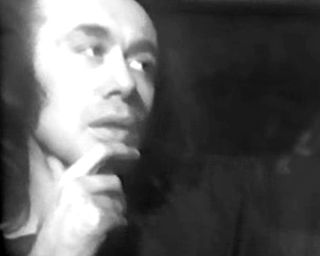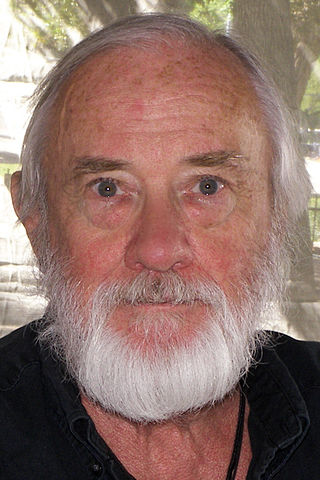Related Research Articles

Vito Acconci was an influential American performance, video and installation artist, whose diverse practice eventually included sculpture, architectural design, and landscape design. His foundational performance and video art was characterized by "existential unease," exhibitionism, discomfort, transgression and provocation, as well as wit and audacity, and often involved crossing boundaries such as public–private, consensual–nonconsensual, and real world–art world. His work is considered to have influenced artists including Laurie Anderson, Karen Finley, Bruce Nauman, and Tracey Emin, among others. Acconci was initially interested in radical poetry, but by the late 1960s, he began creating Situationist-influenced performances in the street or for small audiences that explored the body and public space. Two of his most famous pieces were Following Piece (1969), in which he selected random passersby on New York City streets and followed them for as long as he was able, and Seedbed (1972), in which he claimed that he masturbated while under a temporary floor at the Sonnabend Gallery, as visitors walked above and heard him speaking.
Wisconsin Death Trip is the debut studio album by American heavy metal band Static-X, released on March 23, 1999, by Warner Bros. Records. The band was formed after lead singer Wayne Static and drummer Ken Jay met at a Virgin Records store in Chicago. After being introduced by the Smashing Pumpkins lead singer Billy Corgan, the two decided to head out west to California to enlist a lead guitarist and bassist. Once in California, Koichi Fukuda became guitarist, and not long after, they discovered Californian Tony Campos to complete the lineup as their bassist. Warner Bros. Records discovered the band in California and signed them in February 1998.

Wisconsin Death Trip is a 1973 historical nonfiction book by Michael Lesy, originally published by Pantheon Books. It charts numerous sordid, tragic, and bizarre incidents that took place in and around Jackson County, Wisconsin between 1885 and 1900, primarily in the town of Black River Falls. The events are outlined through actual written historical documents—primarily articles published in the town newspaper—with additional narration by Lesy, as well as excerpts from works by Hamlin Garland, Sinclair Lewis, and Glenway Wescott, which thematically parallel the incidents depicted. The text is accompanied by contemporaneous photographs and portraits taken in Black River Falls by photographer Charles Van Schaick. Thematically, the book emphasizes the harsh aspects of Midwestern rural life under the pressures of crime, pestilence, mental illness, and urbanization.

Robert Anthony Stone was an American novelist. He was twice a finalist for the Pulitzer Prize and once for the PEN/Faulkner Award. Stone was five times a finalist for the National Book Award for Fiction, which he did receive in 1975 for his novel Dog Soldiers. Time magazine included this novel in its list TIME 100 Best English-language Novels from 1923 to 2005. Dog Soldiers was adapted into the film Who'll Stop the Rain (1978) starring Nick Nolte, from a script that Stone co-wrote.

Garry Winogrand was an American street photographer, known for his portrayal of U.S. life and its social issues, in the mid-20th century. Photography curator, historian, and critic John Szarkowski called Winogrand the central photographer of his generation.
Frank Gohlke is an American landscape photographer. He has been awarded two Guggenheim fellowships, two fellowships from the National Endowment for the Arts, and a Fulbright Scholar Grant. His work is included in numerous permanent collections, including those of Museum of Modern Art, New York; the Metropolitan Museum of Art; and the Art Institute of Chicago.
Lee Knowlton Blessing is an American playwright best known for his 1988 work, A Walk in the Woods. A lifelong Midwesterner, Blessing continued to work in regional theaters in and around his hometown of Minneapolis through his 40s before relocating to New York City.
Gilles Peress is a French photographer and a member of Magnum Photos.

Stephen Shore is an American photographer known for his images of banal scenes and objects, and for his pioneering use of color in art photography. His books include Uncommon Places (1982) and American Surfaces (1999), photographs that he took on cross-country road trips in the 1970s.
John Meade Haines was an American poet and educator who had served as the poet laureate of Alaska.

George A. Tice is an American photographer. His work depicts a broad range of American life, landscape, and urban environment, mostly photographed in his native New Jersey. He has lived all his life in New Jersey, except for his service in the U.S. Navy, a brief period in California, a fellowship in the United Kingdom, and summer workshops in Maine, where he taught at the Maine Photographic Workshops, now the Maine Media Workshops.
Bruce Gilden is an American street photographer. He is best known for his candid close-up photographs of people on the streets of New York City, using a flashgun. He has had various books of his work published, has received the European Publishers Award for Photography and is a Guggenheim Fellow. Gilden has been a member of Magnum Photos since 1998. He was born in Brooklyn, New York.
Judy Pfaff is an American artist known mainly for installation art and sculptures, though she also produces paintings and prints. Pfaff has received numerous awards for her work, including a John D. and Catherine T. MacArthur Foundation Fellowship in 2004 and grants from the John Simon Guggenheim Memorial Foundation (1983) and the National Endowment for the Arts. Major exhibitions of her work have been held at the University of Wisconsin–Madison, the Denver Art Museum and Saint Louis Art Museum. In 2013 she was elected to the American Academy of Arts and Sciences. Video interviews can be found on Art 21, Miles McEnery Gallery, MoMa, Mount Holyoke College Art Museum and other sources.

Anne Wilkes Tucker was an American museum curator of photographic works. She retired in June 2015.

Bill Dane is a North American street photographer. Dane pioneered a way to subsidize his public by using photographic postcards. He has mailed over 50,000 of his pictures as photo-postcards since 1969. As of 2007, Dane's method for making his photographs available shifted from mailing photo-postcards to offering his entire body of work on the internet.

Wisconsin Death Trip is a 1999 docudrama film written for the screen and directed by James Marsh, based on the 1973 historical nonfiction book of the same name by Michael Lesy. The film dramatizes a series of macabre incidents that took place in and around Black River Falls, Wisconsin in the late-19th century. It utilizes silent black-and-white reenactment footage contrasted with contemporary color footage of the region, along with voice-over narration by Ian Holm, orating contemporaneous newspaper articles written about the occurrences. Original music for the film was composed by DJ Shadow, with original piano music for the closing credits by John Cale.
Blast Books is a New York-based book publisher whose catalog consists of non-fiction books which focus on cultural and historical subjects, often of an obscure or unusual nature. Many of their publications include archival illustrations and photography.
Barbara Bosworth is an American artist, educator, and photographer. She works primarily with a large-format, 8x10 view camera and focuses on the relationship between humans and nature. Bosworth's works have been included in magazines, journals, books and permanent collections, and shown in solo exhibits nationally and internationally. In 1985, she won a Guggenheim fellowship for her photographic work.
Barbara Pugh Norfleet is an American documentary photographer, author, curator, professor and social scientist who used photography as social documentary and allegory to examine American culture. Her photographic work is represented in museum collections around the world. She is founder and curator of a photographic archive on American social history at the Fogg Art Museum at Harvard University.
References
- ↑ Michael Lesy bio at Encyclopedia.com
- ↑ Snapshots 1971–77 at Amazon
- 1 2 Birnbaum, Robert, Interview: Michael Lesy, Identity Theory, September 16, 2003
- 1 2 Hampshire College faculty page for Michael Lesy
- ↑ Holden, Stephen, "Film Review: How a Town In Wisconsin Went Mad", The New York Times, December 1, 1999
- ↑ Marcus, Greil, "A Record of Despair Born of a Single Image", The New York Times, November 28, 1999
- ↑ "Arena -Episodes by date" on Arena series website
- ↑ United States Artists Foundation (2006) "Michael Lesy
- ↑ Guggenheim Foundation Fellowship for Michael Lesy, 2013